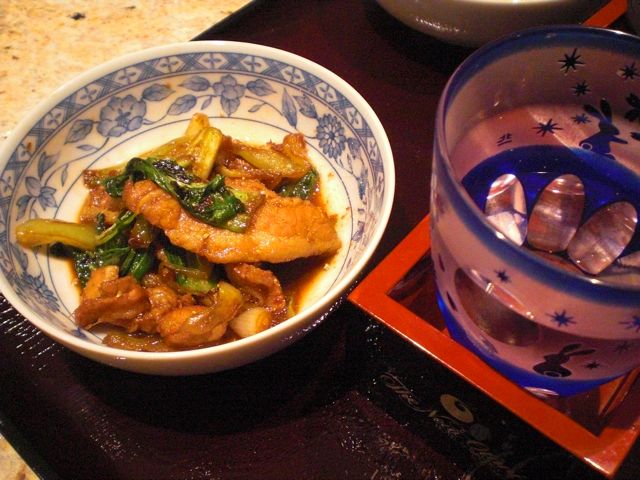When I bought pork belly from the newly opened grocery store in our neighborhood, I made stewed pork belly or "kakuni" 角煮. I took a small block of the more meaty part with alternating fat and red meat layers and sliced it thinly to make "bara-niku" バラ肉 or "sanmai-niku" 三枚肉. This is a very common cut of pork in Japan. It was a really small amount and I made this starter dish one evening from it.

I cut scallions on a slant in 1 inch lengths (5, white part), baby bok choy (1, core removed, white root and stem parts cut into strips with green parts separated).
This has very familiar taste and pork belly really adds to this simple dish. Since I cooked the stalk and green parts of bok choy in different timing, all came out nicely. The fresh ginger note and slight heat (from the white pepper and ginger) were also nice. A perfect Izakaya's "otoshi" dish as well as good for Bento or a Japanese lunch box. We had our house sake Yaegaki "mu" 八重垣 "無" in a hand cut colored glass tumbler with a rabbit motif; one gazing at cherry blossoms and the other watching fireworks, which came from Kitaichi glass 北一硝子 in Otaru 小樽. We should have gotten the autumn and winter ones as well.
I marinated the pork in sake and soy sauce (1:1 ratio) with freshly ground ginger root (1/2 tsp) for 30 minutes or so.
In a hot wok on high flame, I added vegetable oil (1 tbs) with a splash of dark sesame oil. I stir fried the scallion and white part of the bok choy for several minutes. I removed the vegetables and set aside. I seared the pork slices on both sides (1 minute each), put back the vegetables, and stirred for 1 more minute. I added the green parts of the bock choy and added mirin (2 tsp), soy sauce (2 tsp) and freshly grated ginger (1/2 tsp) and very quickly braised. After I removed the wok from the heat, I added freshly ground white pepper.


